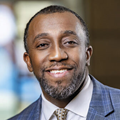“What Did You Say?”: The Power of Effective Communication
 By Andre Harris, MD, chief medical officer, Miami Valley Hospital
By Andre Harris, MD, chief medical officer, Miami Valley Hospital
Almost universally, when I get called to a patient's room for a complaint, they complain about some aspect of communication regarding their care. “I can tell that no one talks to anyone else.” We (health care providers) forget how daunting it can be to place your life in the hands of others. A patient’s access to MyChart and viewing progress notes bring a different type of communication and exposure to knowledge.
In the intricate tapestry of health care, effective communication is the cornerstone of positive patient outcomes and satisfaction. Navigating the complex landscape of medical care necessitates a keen understanding of communication's pivotal role in fostering trust, collaboration, and overall well-being.
Effective communication transcends the exchange of information; it is an art that combines empathy, clarity, and active listening. When health care providers master this art, patients feel heard, understood, and more inclined to actively participate in their care. Creating an environment where patients feel comfortable expressing their concerns, asking questions, and sharing their experiences is essential for building a strong doctor-patient relationship.
Clarity in communication is equally paramount. Medical jargon makes it easy for patients to become overwhelmed and confused. The ability to translate complex medical information into clear, understandable language empowers patients to make informed decisions about their health. This is particularly crucial when discussing treatment plans, potential risks, and the expected outcomes of medical interventions.
Active listening, often an underappreciated skill, is a linchpin of effective communication. Taking the time to truly understand a patient's perspective, concerns, and preferences fosters a sense of partnership in the health care journey. It also allows health care providers to tailor their approach, ensuring that the care provided aligns with the unique needs of each individual.
In the ever-evolving landscape of health care, the integration of technology adds a new dimension to effective communication. Telemedicine, secure messaging platforms, and electronic health records streamline communication channels, offering both convenience and accessibility for patients and providers alike.
For me, as chief medical officer, championing effective communication is not only a professional responsibility but a commitment to patient-centered care. It is the bridge that connects health care providers and patients, forging a path toward improved health outcomes, increased patient satisfaction, and a health care system that truly prioritizes the well-being of those it serves.
Back to the February 2024 issue of Premier Pulse

